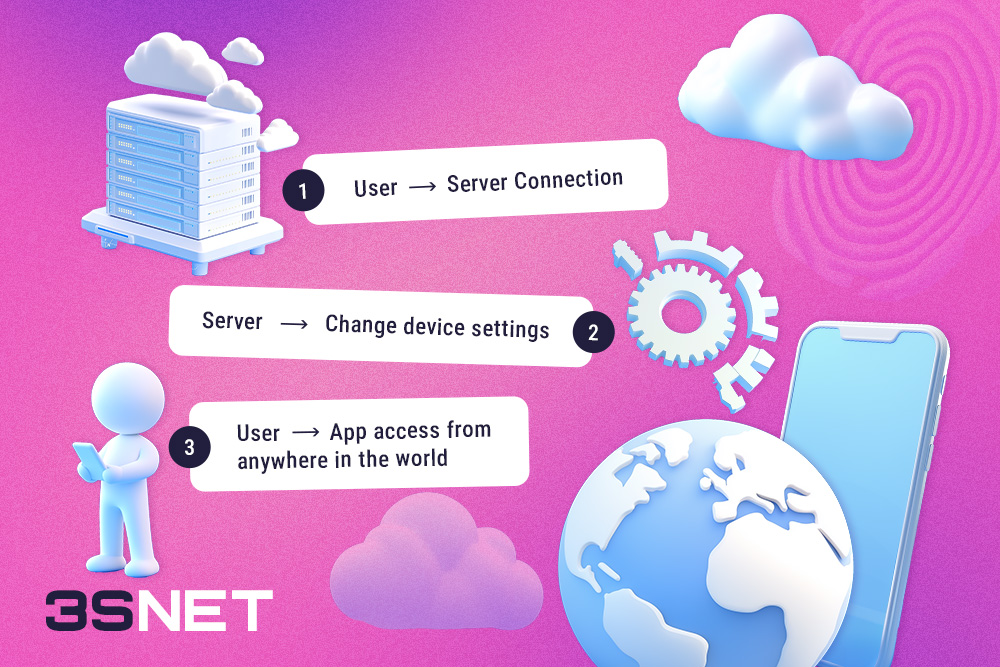
Publication date: 10 January 2025
Media buying is facing new challenges: account bans, difficulties with TikTok and Amazon’s anti-fraud systems, cryptocurrency exchanges, as well as in the gambling and betting verticals. Antidetect phones are not only tools for webmasters. Moreover, they are a powerful antidetect solution for media buying. We spoke with GeeLark, a pioneer in the field, to understand how it works. Meanwhile, the questions were asked, as always, by 3SNET expert and analyst Alex Miller.
What are antidetect phones and why are they needed?
Modern platforms use sophisticated anti-fraud systems that analyze parameters such as IMEI, MAC address, geolocation, application data and even device activity. Traditional anti-detect browsers can handle such tasks in a web environment. However, they are not able to fully work with mobile applications.
Antidetect phones are real Android devices hosted in a cloud infrastructure. They are perfect for handling mobile traffic in verticals such as casinos and bookmakers, as well as managing UBT traffic as a source.
What makes GeeLark unique?
Alex Miller: Let’s get to know GeeLark, a pioneer in this space. What makes their solution unique? We talked to the GeeLark team.
Uniqueness of GeeLark Technologies
| Parameter | Description |
|---|---|
| Device type | A real cloud-based mobile device. |
| Variable data | IP, IMEI, WiFi MAC, Bluetooth, Timezone, Region. |
| Security | High level of anonymity, realistic interaction. |
GeeLark’s cloud-based devices provide access to phones from anywhere in the world. Users don’t have to buy dozens of physical phones, worry about their wear and tear, or customize them.
Key benefits:
- Manage multiple accounts simultaneously;
- Connect to phones without being tied to a location;
- Automatic system updates without replacing the device.
GeeLark’s cloud phones simplify mobile traffic management by bringing a convenient solution to gambling, betting, UBT traffic and other verticals.
How Antidetect Phones Work
Antidetect phones provide functionality that is not available with emulators. In contrast, they support real mobile applications, use fewer resources, and provide anonymity.

Antidetect phones have a wide range of applications. They are used not only in social networks (TikTok, *Instagram) to deal with UBT traffic, but also in other areas:
- Pharming accounts in Telegram and other social networks;
- Marketing through mass accounts;
- E-commerce;
- Testing Android applications on real phone profiles;
- Gaming the cryptocurrency ecosystem, including Web 3.0;
For example, a webmaster working with TikTok connects to a cloud phone where the IMEI, IP and MAC are automatically changed. They can then use the TikTok app to manage their ad accounts and avoid getting blocked.
This versatile approach makes antidetect phones a valuable tool for both media buyers and developers.
How antidetect phones differ from emulators and other solutions
Emulator vs. Antidetect phone
An emulator is software that allows you to run one operating system or application inside another, such as Android inside Windows. Emulators create a virtual environment that mimics a physical device.
Examples of emulators include
- BlueStacks (for running Android apps on a PC);
- Genymotion (for testing Android apps).
Features of emulators:
- Work in a virtual environment without using real devices;
- Often used to test applications or games;
- Easily detected by anti-fraud systems due to standard digital fingerprints.
An antidetect phone is software designed to mask user and device information. It not only modifies the superficial data like an emulator, but also creates a unique digital “fingerprint” of the device to minimize the likelihood of detection.
What does the anti-detect phone do?
- Changes device identifiers: IMEI, MAC address, advertising identifiers;
- Corrects system parameters: Android version, manufacturer information, screen resolution, device model, etc;
- Replaces network data: IP address, geolocation, proxy.
What is the main difference?
1) The emulator works in a virtual environment without being bound to physical hardware. Antidetect Phone is a cloud-based solution that simulates the behavior of a real smartphone.
2) An Antidetect Phone focuses on bypassing blocks by creating unique digital fingerprints. Emulators, on the other hand, often have predictable and easily identifiable characteristics.
Comparison for simplicity, an emulator is like a driving simulator (it “pretends” to be one), while an antidetect phone is a real car, just with altered license plates and characteristics.
| Parameter | Emulators | GeeLark Antidetect Phones |
| Resources | High | Minimal |
| Detection | Often detected | Not detected |
| Mobile Apps | Limited options | Full support |
| Account Management | Less user-friendly | Intuitive |
| Blocking Risks | High | Minimal |
| System Updates | Manual configuration required | Automatic updates |
| Physical Device Costs | Additional devices required | Not required |
Alex Miller: Every technology has both benefits and risks. What challenges do your customers face and how do you help them overcome them?
Advantages of antidetect phones for Web 3.0 games
Antidetect phones are in demand in crypto games and the Web 3.0 ecosystem. A use case example was provided by one of GeeLark’s top partners, influencer DefiWimar. In his X account, he shared real-world results with such phones:
“$DOGS Sybiling brought me $32,782. Now, I’m managing 500 accounts in $CATS App, with ~$45,700 estimated profit.”
This means that by pharming accounts in the crypto games $DOGS and $CATS, the author has earned over $78,000. In addition, he attached screenshots of his account pharming and showed how the use of cloud phones allowed him to scale his income in Web 3.0 games.
Antidetect phones are not just a tool for circumventing blockers, but a powerful solution for scaling a Web 3.0 business. Learn more about such games and Telegram’s features in the article: “Telegram: new opportunities for gaming and gambling“.
How to use antidetect phones to deal with UBT?
UBT traffic is one of the main sources of mobile traffic.
The short video formats such as TikTok, YouTube Shorts and Instagram Stories* require active account networks.
UBT traffic (User-Generated Content Based Traffic) is user-generated content (UGC) based traffic. The terms are often used interchangeably: UBT = UGC traffic.
- What is UGB traffic and how to work with it? Read the 3S.INFO Knowledge Base!
GeeLark Antidect phones are suitable for UBT traffic management:
- The ability to work with real applications;
- Keep accounts active without the risk of being blocked;
- Flexibility to manage multiple devices for bookmaker and casino traffic.
UBT traffic is based on users interacting with content created for them. For example, TikTok’s short videos require constant activity from accounts in order for the platform’s algorithms to perceive them as organic users. Antidetect phones allow such accounts to be managed, creating real interaction that is not possible with emulators.
Intuitive Interface and Process Automation in GeeLark
GeeLark was designed with an intuitive interface in mind. Beginners can quickly get up to speed with tutorials, support, and pre-built guides.
For advanced users, flexible customization via APIs and the ability to automate processes are available.
The future of fraud prevention: antidetect phones
Antidetect phones are a must-have for mobile media buying. We’ve covered how antidetect phones help create unique digital footprints and work across all mobile verticals. Now it’s your turn:
- GeeLark: Try for free for 60 minutes and get 20% off.
- 3SNET: Best mobile traffic offers, flexible plans and professional support!
Start earning more today!
*Instagram is blocked in Russia by court order.
Share it with your friends via favorite social media































